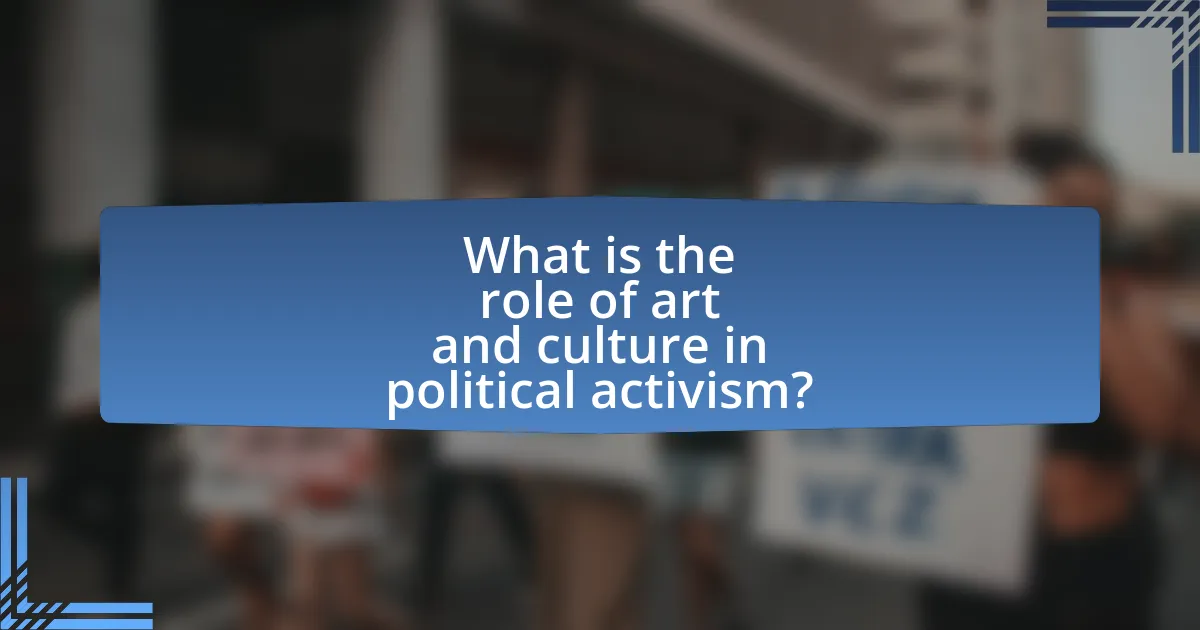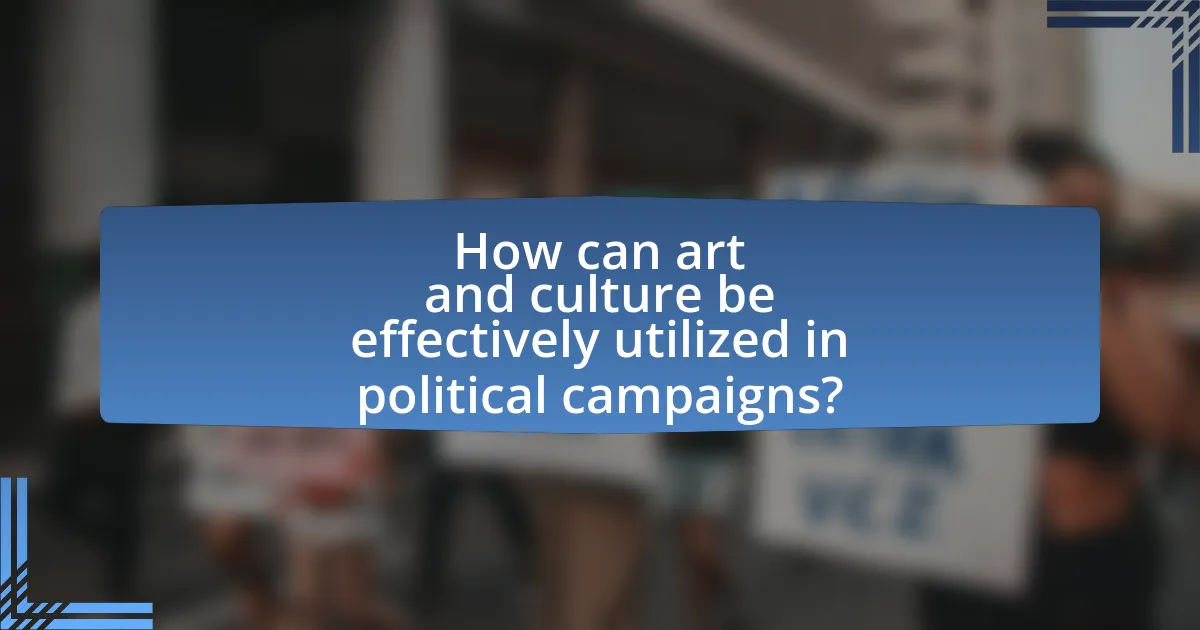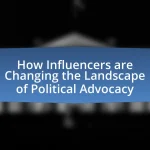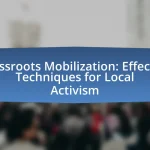The article focuses on the significant role of art and culture in political activism, highlighting how these elements serve as tools for expression, mobilization, and awareness. It discusses various forms of art, including visual art, music, performance, and literature, and their historical impact on political movements, such as the Civil Rights Movement and the Mexican Revolution. The article also examines the influence of cultural identity and narratives on political engagement, the effectiveness of different artistic mediums in conveying political messages, and the challenges artists face in activism, including censorship and public backlash. Additionally, it provides practical strategies for incorporating art into political campaigns to enhance community engagement and foster social change.

What is the role of art and culture in political activism?
Art and culture play a crucial role in political activism by serving as powerful tools for expression, mobilization, and awareness. They enable activists to communicate complex social issues in relatable and impactful ways, often transcending language barriers. For instance, visual art, music, and performance have historically been used to convey messages of resistance and solidarity, as seen in movements like the Civil Rights Movement in the United States, where songs and visual art galvanized public support and highlighted injustices. Additionally, cultural events and artistic expressions can foster community engagement and solidarity, creating a shared identity among activists. This connection is evidenced by the use of street art in protests, which not only beautifies public spaces but also provokes thought and dialogue about pressing political issues.
How does art influence political movements?
Art influences political movements by serving as a powerful tool for expression, mobilization, and awareness. Through various forms such as visual art, music, and performance, artists can convey messages that resonate with the public, often highlighting social injustices and rallying support for change. For instance, the use of protest songs during the Civil Rights Movement in the United States, such as “We Shall Overcome,” galvanized communities and inspired collective action. Additionally, visual art, like the murals created during the Mexican Revolution, played a crucial role in shaping public perception and identity, effectively communicating political ideologies. These examples demonstrate that art not only reflects societal issues but also actively participates in shaping political discourse and motivating movements.
What are the historical examples of art in political activism?
Historical examples of art in political activism include the works of Diego Rivera, whose murals depicted social issues and the struggles of the working class in Mexico during the early 20th century. Rivera’s mural “Man at the Crossroads” was commissioned for the Rockefeller Center in 1933 but was destroyed due to its political content, illustrating the tension between art and political power. Another significant example is the use of protest songs during the Civil Rights Movement in the United States, with artists like Bob Dylan and Joan Baez using their music to advocate for social change and equality. Additionally, the Dada movement emerged as a reaction to World War I, using absurdity and anti-establishment themes to critique societal norms and political structures. These instances demonstrate how art has historically served as a powerful tool for political expression and activism.
How does art shape public perception of political issues?
Art shapes public perception of political issues by providing a medium for expression that can evoke emotional responses and provoke critical thinking. Through visual art, music, literature, and performance, artists can highlight social injustices, challenge dominant narratives, and inspire collective action. For instance, the use of protest art during the Civil Rights Movement in the United States, such as the works of artists like Jacob Lawrence, effectively communicated the struggles and aspirations of African Americans, influencing public opinion and policy changes. Additionally, contemporary street art, like that of Banksy, often critiques political systems and engages the public in dialogue about pressing issues, demonstrating art’s power to shape perceptions and mobilize communities.
Why is culture important in political activism?
Culture is important in political activism because it shapes identities, values, and social norms that influence collective action. Cultural expressions, such as art, music, and literature, serve as powerful tools for mobilizing communities, raising awareness, and fostering solidarity among activists. For instance, the Civil Rights Movement in the United States utilized music and visual art to communicate messages of resistance and hope, effectively engaging a broader audience and inspiring action. This demonstrates that culture not only reflects societal issues but also actively participates in the political discourse, making it a vital component of effective activism.
How does cultural identity impact political engagement?
Cultural identity significantly impacts political engagement by shaping individuals’ values, beliefs, and behaviors related to political participation. Individuals with strong cultural identities often feel a sense of belonging and responsibility towards their community, which can motivate them to engage in political activities such as voting, advocacy, and activism. For instance, research by the Pew Research Center indicates that cultural factors, including ethnicity and religion, influence political preferences and participation rates, with minority groups often mobilizing around shared cultural experiences to advocate for their rights and interests. This connection between cultural identity and political engagement highlights the importance of understanding diverse perspectives in political discourse and activism.
What role do cultural narratives play in activism?
Cultural narratives play a crucial role in activism by shaping public perception and mobilizing communities around social issues. These narratives provide a framework through which individuals understand their experiences and the injustices they face, often fostering a sense of identity and belonging. For example, the civil rights movement utilized cultural narratives through music, literature, and visual art to communicate messages of resistance and hope, effectively galvanizing support and action. Research indicates that storytelling within cultural contexts can enhance empathy and drive engagement, as seen in campaigns like “Black Lives Matter,” which leverage personal narratives to highlight systemic racism and police brutality.

What are the different forms of art used in political activism?
Different forms of art used in political activism include visual art, performance art, music, literature, and digital media. Visual art, such as graffiti and murals, often conveys powerful political messages and critiques societal issues, exemplified by the works of artists like Banksy. Performance art engages audiences in real-time, often addressing political themes through interactive experiences, as seen in the works of artists like Marina Abramović. Music serves as a rallying cry for movements, with protest songs historically uniting people, such as “We Shall Overcome” during the Civil Rights Movement. Literature, including poetry and essays, articulates political dissent and inspires action, with authors like George Orwell and Audre Lorde making significant contributions. Digital media, including social media campaigns and online art, amplifies political messages and mobilizes communities, as demonstrated by the viral impact of the #MeToo movement. Each of these art forms plays a crucial role in shaping public discourse and fostering social change.
How do visual arts contribute to political messages?
Visual arts contribute to political messages by serving as powerful tools for communication and expression, enabling artists to convey complex social and political issues visually. For instance, works like Picasso’s “Guernica” illustrate the horrors of war and oppression, effectively raising awareness and evoking emotional responses from viewers. Additionally, contemporary street art, such as Banksy’s pieces, often critiques political systems and social injustices, making political commentary accessible to a broader audience. These visual representations can mobilize public opinion, inspire activism, and foster dialogue, demonstrating the significant role of visual arts in shaping political discourse.
What types of visual art are most effective in activism?
The types of visual art most effective in activism include street art, posters, and photography. Street art, such as murals and graffiti, often captures public attention and conveys powerful messages in accessible locations, making it a potent tool for social change. Posters, particularly those used in protests, can quickly disseminate information and rally support for causes, as seen in the Women’s March in 2017 where iconic imagery and slogans were widely shared. Photography, especially documentary photography, can evoke emotional responses and raise awareness about social issues, exemplified by the impactful work of photojournalists during the Civil Rights Movement. These forms of visual art effectively engage audiences, provoke thought, and inspire action, thereby playing a crucial role in activism.
How do murals and street art engage communities politically?
Murals and street art engage communities politically by serving as visual platforms for social commentary and activism. These forms of art often address pressing social issues, such as inequality, racism, and environmental concerns, thereby fostering dialogue and awareness among community members. For instance, the “Black Lives Matter” mural in Washington, D.C. not only symbolizes the movement but also encourages public discourse on racial justice. Additionally, studies show that public art can enhance community identity and solidarity, as seen in the case of the “Hope” poster during the 2008 Obama campaign, which galvanized support and participation in the electoral process. Through these artistic expressions, communities are mobilized to reflect on their political realities and advocate for change.
What is the significance of performance art in activism?
Performance art plays a crucial role in activism by providing a visceral and immediate means of communication that engages audiences emotionally and intellectually. This form of art often addresses social and political issues directly, creating a powerful platform for marginalized voices and fostering public dialogue. For instance, the work of artists like Marina Abramović and the Guerrilla Girls has highlighted issues such as gender inequality and systemic violence, effectively raising awareness and prompting action. Performance art’s ability to transform public spaces into sites of protest allows for spontaneous interaction and reflection, making it a significant tool in the arsenal of contemporary activism.
How does theater and dance convey political messages?
Theater and dance convey political messages by using performance as a medium to express social issues, critique power structures, and inspire change. Through storytelling, choreography, and visual symbolism, these art forms can highlight injustices, provoke thought, and mobilize audiences. For instance, the play “The Vagina Monologues” addresses women’s rights and sexual violence, while the dance piece “The Rite of Spring” has been interpreted as a commentary on societal upheaval. Historical examples, such as the use of theater in the Civil Rights Movement, demonstrate how performances can galvanize public sentiment and influence political discourse.
What are some notable performance art pieces that influenced political change?
Notable performance art pieces that influenced political change include “The Artist is Present” by Marina Abramović, which highlighted issues of presence and engagement in a politically charged environment, and “The Guerrilla Girls” performances, which addressed gender and racial inequality in the art world. Additionally, “The Vagina Monologues” by Eve Ensler raised awareness about women’s rights and violence against women, contributing to the global V-Day movement. Each of these works not only engaged audiences but also sparked discussions that led to tangible political activism and social change.

How can art and culture be effectively utilized in political campaigns?
Art and culture can be effectively utilized in political campaigns by creating emotionally resonant messages that engage voters and foster community identity. For instance, visual art, music, and performance can convey complex political ideas in accessible ways, making them memorable and impactful. Historical examples include the use of protest songs during the Civil Rights Movement, which galvanized public support and raised awareness about social injustices. Additionally, cultural events and art installations can serve as platforms for dialogue, encouraging participation and activism among diverse groups. Research indicates that campaigns incorporating artistic elements can increase voter turnout by appealing to emotions and shared values, thereby enhancing the overall effectiveness of political messaging.
What strategies can activists use to incorporate art into their campaigns?
Activists can incorporate art into their campaigns by utilizing visual art, performance art, and digital media to convey their messages effectively. Visual art, such as murals and installations, can create impactful public displays that raise awareness and provoke thought about social issues. Performance art can engage audiences emotionally and create memorable experiences that resonate with the public, as seen in events like the “AIDS Memorial Quilt,” which combined art with activism to highlight the AIDS crisis. Digital media, including social media campaigns featuring art, can reach a broader audience and encourage participation, exemplified by the viral success of the “Ice Bucket Challenge,” which used creative visuals to promote awareness for ALS. These strategies demonstrate how art can enhance the visibility and emotional impact of activist campaigns, making complex issues more accessible and relatable to diverse audiences.
How can social media amplify the impact of art in activism?
Social media amplifies the impact of art in activism by providing a global platform for artists to share their work and messages instantly. This accessibility allows art to reach diverse audiences, fostering engagement and dialogue around social issues. For instance, campaigns like #BlackLivesMatter have utilized visual art and graphics shared on platforms like Instagram and Twitter to raise awareness and mobilize support, demonstrating how art can drive social change. Additionally, studies show that visual content is more likely to be shared, increasing the visibility of activist messages; for example, a report by BuzzSumo found that images on social media generate 650% higher engagement than text-only posts.
What are the best practices for collaborating with artists in political movements?
The best practices for collaborating with artists in political movements include establishing clear communication, aligning on shared goals, and respecting artistic autonomy. Clear communication ensures that both activists and artists understand each other’s perspectives and objectives, which is crucial for effective collaboration. Aligning on shared goals helps to create a unified message that resonates with the audience, enhancing the impact of the political movement. Respecting artistic autonomy allows artists to express their creativity freely, which can lead to innovative and powerful expressions of political messages. Historical examples, such as the collaboration between artists and civil rights activists during the 1960s, demonstrate that these practices can lead to significant cultural and political change.
What challenges do artists face in political activism?
Artists face several challenges in political activism, including censorship, financial instability, and public backlash. Censorship can occur when governments or institutions restrict artistic expression that critiques political systems or social issues, limiting the artist’s ability to convey their message. Financial instability arises as artists often rely on grants, sponsorships, or sales, which can be jeopardized if their work is deemed controversial or politically charged. Public backlash can manifest as negative reactions from audiences or communities, potentially leading to social ostracism or threats to personal safety. These challenges can hinder artists’ effectiveness in advocating for political change through their work.
How can censorship affect artistic expression in activism?
Censorship can significantly restrict artistic expression in activism by limiting the themes and messages that artists can convey. When governments or institutions impose censorship, they often target works that challenge the status quo or provoke critical thought, thereby stifling dissent and reducing the diversity of voices in public discourse. For instance, during the 2011 Arab Spring, many artists faced censorship that curtailed their ability to address political issues, which hindered the effectiveness of their activism. This suppression not only affects individual artists but also diminishes the overall impact of art as a tool for social change, as it prevents the exploration of critical societal issues and the mobilization of communities around them.
What are the risks artists take when engaging in political activism?
Artists face significant risks when engaging in political activism, including potential backlash, censorship, and personal safety threats. Backlash can manifest as public criticism, loss of audience, or damage to reputation, as seen in cases where artists have faced social media campaigns against them for their political views. Censorship may occur when governments or institutions restrict artistic expression, limiting the artist’s ability to convey their message, as evidenced by instances where artworks have been removed from exhibitions due to political content. Additionally, personal safety threats can arise, particularly in oppressive regimes, where artists may face harassment, imprisonment, or violence for their activism, highlighting the dangers associated with using art as a form of political expression.
What are some practical tips for using art and culture in political activism?
Utilizing art and culture in political activism can be effectively achieved through several practical tips. First, create art that resonates with the community’s experiences and struggles, as seen in the works of artists like Ai Weiwei, who uses his art to address human rights issues. Second, collaborate with local artists to organize community events that promote awareness and engagement, similar to the “Art for Change” initiatives that have successfully mobilized communities around social justice issues. Third, leverage social media platforms to share artistic expressions and cultural narratives that highlight political messages, as demonstrated by the viral impact of the “Black Lives Matter” murals. Fourth, incorporate performance art, such as theater or spoken word, to convey powerful messages and evoke emotional responses, which has been effective in movements like the Women’s March. Lastly, use public spaces for art installations that provoke thought and dialogue, akin to the “Fearless Girl” statue that sparked conversations about gender equality. These strategies not only amplify political messages but also foster community solidarity and inspire action.


